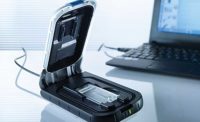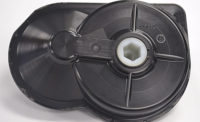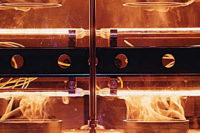Ultrasonic Welder Assembles Plastic Water Pitcher

The iQ series ultrasonic servo welder produces reliable and repeatable welds. Photo courtesy Dukane Corp.

KeyTronicEMS uses the iQ series ultrasonic servo welder to weld a filter-change light into the lid of the PUR plastic pitcher. Photo courtesy KeyTronicEMS


Quality is just as important to consumers as the brand name. Knowing this, electronics manufacturing services provider KeyTronicEMS makes sure its OEM customers brands are synonymous with quality.
Based in Spokane, WA, KeyTronicEMS has manufactured a wide range of products since the mid-1970s—from simple consumer devices to complex, high-end commercial, medical, military and industrial electromechanical products. The company’s in-house capabilities include full-product and PCB assembly; plastic injection and blow molding; precision metal stamping, fabrication and finishing; and engineering services.
With factories in the United States, Juarez, Mexico, and Shanghai, China, KeyTronic has more than 1 million square feet of manufacturing space. Phil Hochberg, executive vice president of business development for KeyTronicEMS, says the company focuses on customers with low to medium volumes and high flexibility requirements.
Recently, KeyTronic contracted with Kaz USA Inc. to weld a filter-change light into the lid of the PUR water pitcher. This light tracks how long the filter has been in the pitcher. After a specific duration of time, the light changes color so the consumer knows to replace the filter and reset the light.
KeyTronicEMS selected Dukane Corp.’s iQ series ultrasonic servo welder for this application because of prior usage and success. In fact, KeyTronic has operated 10 of the welders in its factories since 2011—including the 500th iQ servo welder made by Dukane. Hochberg says that standardizing welders helps the company save money on spare parts and maintenance.
“[This welder] ensures that the product is properly sealed and performs to our customer’s expectations,” notes Hochberg. “The quality we yield out of [this] and other processes where we use Dukane machines is very good. Cosmetic problems are minimal.”
Traditionally, ultrasonic welders have relied on pneumatics for actuation of the ultrasonic transducer. In contrast, the iQ welder features a servo actuator that uses Melt-Match technology to drive the transducer.
Melt-Detect, a component of that technology, allows the welder to turn on ultrasonic energy with no downward movement from the ram once part contact has been detected. The welder then waits at this position until a drop in force has been detected, which indicates that melting has begun.
Melt-Detect can be programmed to define a percent of drop in force that must be observed, below the trigger point, before downward motion is initiated. This feature allows the welder to be triggered by very low forces and shortens cycle time.
To enhance bond strength, the iQ welder allows precise programming of collapse distance and velocity during the melt and post-weld stages. Repeatability is 1 micron.
The iQ series includes 15-, 20-, 30-, 40- and 50-kilohertz welders, with power ranges from 150 to 5,000 watts.
“This machine is very easy to program, operate and troubleshoot, and it [produces] welds at different distances and strengths,” concludes Hochberg. “We are able to quickly define the process, keep it under control and minimize variability between parts.”
For more information on ultrasonic servo welders, call 630-797-4900 or visit www.dukane.com/us.
Looking for a reprint of this article?
From high-res PDFs to custom plaques, order your copy today!








